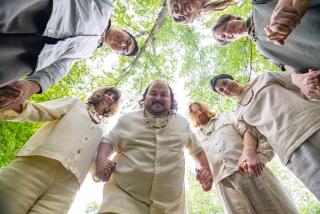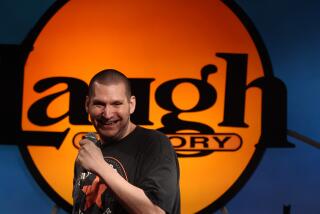Teacher Lifts Self-Esteem Along With Spirits by Laughing at Life
- Share via
Your belly aches, your cheeks are red, you are short of breath and just can’t stop yourself. The man laughs. He rubs his belly, a chubby finger points at several words printed on a sheet of paper. You must do as the words command. When it’s over, he gives you a “high-five” and proclaims: “You’ve got a good laugh!”
You have just finished a laugh drill created by Bob Moss, a UC San Diego physical education teacher, lecturer, laugh guru and purveyor of enthusiasm.
The drill is an a exercise in laughing in several distinct ways. You know: har-har, ha-ha, yuk-yuk, ho-ho. . . . And it is one of the techniques Moss uses to build self-esteem among students in his classes and at the private seminars he frequently hosts.
“Laughter is a creative process,” Moss said. “I use it to help students gain more confidence. . . . Beginning students cannot always hit a ball, but everybody can laugh,” he said.
Moss, 50, is the kind of man who can easily inspire laughter. He is 6-feet, 2-inches tall and his weight is “classified.” He wears fluorescent pink-frame sunglasses and a sweat shirt that stretches over his rotund frame. The sweat shirt is imprinted with his motto: “Hubba Jubba 2-U. . . . Enthusiasm, Catch It!”
Laughter is serious business, you see. By learning to laugh, students relax, learn faster and easier. Improvement builds enthusiasm, which leads to even more learning, which leads to high self-esteem, which can lead to--anything, said Moss, who teaches tennis and softball at UCSD.
“It’s a lifestyle. So regardless of the situation--a classroom, a speech, on the job--the idea is for them to become more confident,” Moss said.
Moss also officiates at high school games and in an informal survey by The Times in February he was named as the Biggest Clown by high school basketball coaches.
But it’s not all a barrel of laughs, Moss has also made a “mirror box” so that his students, particularly those in his tennis class, can actually see themselves as they are learning the game.
“Many times people know they fail, but they can’t see why they failed. . . . The mirrors help them see the mistakes their bodies are making,” Moss said.
Another technique Moss uses to get students involved in their sport is a game known as “My Name and Claim to Fame,” said Emily Ford, a rower and one of Moss’ independent studies students.
Ford and the other rowers on UCSD’s novice women’s rowing team played the game to prepare themselves for last Saturday’s Pacific Coast Rowing Championship. (The rowing team finished 6th out of a field of 19.)
“We said our names and then yelled out what our greatest contribution to the team in the past year was,” Ford said. “We also used a song to energize the team. We’re all excited now.”
Chuck Millenbah, chairman of the Physical Education Department at UCSD, said Moss’ laughter drills, mirror box, and overall enthusiasm about life help students relax so they can concentrate on the tasks at hand.
“Laughter won’t hit the tennis ball,” Millenbah said. “But he tries to make all our students relax and have confidence so they won’t be afraid to participate. He’s a huge guy, but he’s also very gentle and caring.”
Outside of the sports arena, Moss uses his games, his laughter and other tools to inspire positive feelings among the groups he frequently addresses.
One of those was a group of about 20 teen-age girls he met earlier this month, students at Sierra Vista High School. The girls are part of the court school program and are serving sentences ranging from four months to one year.
“That was a real test of my own confidence,” Moss said. “These girls were looking at me and saying ‘What’s this big guy gonna do for me?’ ”
What he did for the girls was enable them to laugh at themselves more readily, said Cherry Stockton, their teacher.
“You never know what kind of long-term effect you have on the girls,” Stockton said. “I can’t say he had a great effect on them because a lot of the changes we see in the girls come in small increments.” But now, Stockton said, when the girls say their names, they seem to say the words with more pride in themselves.
Following Moss’ visit, another visitor came to speak to the class, Stockton said. “One of the girls walked up to him, shook his hand and introduced herself. I knew that was because of Bob’s visit. In the past she wasn’t very confident, but (Moss) gave a bolster to her confidence.”
Before leaving, Moss took an instant picture of each girl in what he calls the “tah-dum” position, arms outstretched with a big smile.
Moss claims to have taken more than 70,000 pictures of people in that position, which he then gives them. He hopes the happy pictures will become part of their lives.
But Moss’ life hasn’t always been a bucket of cheer. He began teaching at UCSD in 1971 after the disappointment of not making it as a major league umpire. Although he had umpired in the minor leagues for three years, and before that had officiated at high school games, Moss never received a call from the big leagues.
Moss had dreamed of being the next Emmett Ashford, the first black umpire in the major league. But he thinks his outlandish personal style cost him an offer to join the majors.
“But, out of negatives, there come positives,” Moss said. “If I had become a major league umpire, that’s all I would have been.” Not making it to the major leagues gave Moss the chance to teach and to encourage people to be excellent, he said.
More to Read
Get our high school sports newsletter
Prep Rally is devoted to the SoCal high school sports experience, bringing you scores, stories and a behind-the-scenes look at what makes prep sports so popular.
You may occasionally receive promotional content from the Los Angeles Times.






